Repeaters and hubs
1. Repeater
A repeater (RP repeater) is a device that connects network lines, and is often used for two-way forwarding of physical signals between two network nodes. The repeater is the simplest network interconnection device. It mainly completes the functions of the physical layer. It is responsible for transmitting information in bits on the physical layers of the two nodes, and completes the functions of signal replication, adjustment, and amplification to extend the length of the network. Its position in the OSI reference model is shown in Figure 1.
Due to the loss, the power of the signal transmitted on the line will gradually attenuate. When it is attenuated to a certain degree, it will cause signal distortion and therefore will lead to reception errors. The repeater is designed to solve this problem. It completes the connection of the physical line, amplifies the attenuated signal, and keeps the same as the original data.
In general, the two ends of the repeater are connected to the same media, but some repeaters can also complete the transfer of different media. Theoretically speaking, the use of repeaters is unlimited, so the network can be extended indefinitely. In fact, this is not possible, because the network standard specifies the delay range of the signal, and the repeater can only work effectively within this specified range, otherwise it will cause network failure. The Ethernet network standard stipulates that only 5 network segments are allowed on an Ethernet network, and at most 4 repeaters are used, and only 3 network segments can be connected to computer terminals.
Second, the hub
Hub (Hub) is a form of repeater, the difference is that the hub can provide multi-port services, also known as multi-port repeater. The location of the hub in OSI / RM is shown in Figure 2.
The development of hub products is rapid, and LAN hubs are usually divided into five different types, which will have a direct impact on the development of LAN switch technology.
1. Single trunk network hub
In the hardware platform, the first type of hub is a simple relay LAN segment. The best example is a superimposed Ethernet hub or Token Ring Multi-Station Access Unit (MAU). Some vendors try to draw a line between manageable hubs and unmanageable hubs for hardware classification. The core feature of the network hardware itself is ignored here, that is, what function it implements, rather than how to easily configure it.
2. Multi-segment hub
The multi-segment hub is directly derived from the first type of hub, using a hub backplane, this hub has multiple trunk network segments. Multi-segment hubs are usually chassis systems with multiple interface card slots. However, some non-modular stacking hubs now also support multiple trunk network segments. The main technical advantage of the multi-segment hub is that users can be distributed on multiple relay network segments to reduce the information traffic load of each network segment. The information traffic between network segments generally requires an independent bridge or router.
3. Port switching hub
The port switching hub is based on the multi-segment hub to automate the connection process between user ports and multiple backplane network segments, and is achieved by adding a port switching matrix (PSM). PSM provides an automated tool for connecting any external user port to any trunk segment on the hub backplane. The key to this technology is "matrix". A matrix switch is a cable switch. It cannot operate automatically and requires user intervention. It cannot replace a bridge or router, and does not provide connectivity between different LAN segments. Its main advantage is the automation of movement, addition, and modification.
4. Network interconnect hub
Port switching hubs focus on port switching, while network interconnect hubs actually provide some type of integrated connection between multiple network segments on the backplane. This can be done through an integrated bridge, router or LAN switch. At present, such hubs are usually in the form of chassis.
5. Switching hub
At present, the line between the hub and the switch has become blurred. The switching hub has a core switching backplane and uses a pure switching system to replace the traditional shared media trunk network segment. Such products are already on the market, and hybrid (trunk / switch) hubs are likely to control this market in the next few years. It should be noted that there is almost no difference in the characteristics between hubs and switches.
Antenk DIN41612 Connectors are a versatile two piece PCB connector set with feaures useful for many applications including connections for plug-in card and back-panel wiring, PCB to PCB attachment and peripheral connections for external interfaces. Features include a multitude of body sizes and styles with options that include selective contact loading, make and break contacts, contact lead length choices and contact plating variations each in .100" [2.54mm] or .200" [5.08mm] centerline spacing.
The DIN 41612 standard covers a series of two-piece backplane connectors widely used in rack-based telecommunication, computing, process control, medical, industrial automation, test and measurement and military/aerospace systems where long-term reliability is required. They consist of one to three rows of contacts in combinations of 16, 32, 48, 64, or 96 contacts on a 0.1-inch (2.54 mm) grid pitch. The 3 rows are labelled a, b and c and connectors up to 64 way if using a 96 way body can use either rows a+b or a+c. DIN 41612 Signal connectors can be rated to 1.5 amps per signal pin, at 500 volts, although these figures may be de-rated according to safety requirements or environmental conditions. Several hybrid power and coaxial configurations are available that can handle up to 5.6A or even 15A. This wealth of variations explains the very wide range of applications that they`re put to. For over 30 years these DIN 41612 `Euro Card` connectors to IEC 60603-2 have offered a highly reliable system for board interconnects. Precision contact density, low mating forces, a two piece protective design and many contact termination styles offer unlimited design opportunities. Termination methods include – straight PC, solder eyelet, wire wrap, crimp and [press fit" terminals. Insertion and removal force are controlled, and three durability grades are available. Standardisation of the connectors is a prerequisite for open systems, where users expect components from different suppliers to operate together; ept and Conec DIN 41612 are therefore fully intermateable with all other similarly compliant products from other manufacturers like Harting, Erni, Hirose and TE Connectivity, etc.
The most common connector in the DIN product line is type C, which is widely used in VMEbus systems, the DIN 41612 standard has been upgraded to meet international standards IEC 60603-2 and EN 60603-2. In the past, ept used a comb supported press-fit tool for their type C and B press-fit female connectors. To be more competitive, ept has changed to flat-rock technology (just a flat piece of steel pushed on the top of the connector) as used by many other manufacturers.
DIN 41612 Connectors are widely used in rack-based electrical systems. The standard performance of these connectors is a 2 A per pin current carrying capacity and 500 V working voltage. Both figures may be variable due to safety and environmental conditions.
Types
Number of contacts varies
Many variations of housing material, including different types of metal and plastic
Both angled and straight versions
Male and female
C,R,B,Q Type DIN41612 Connectors
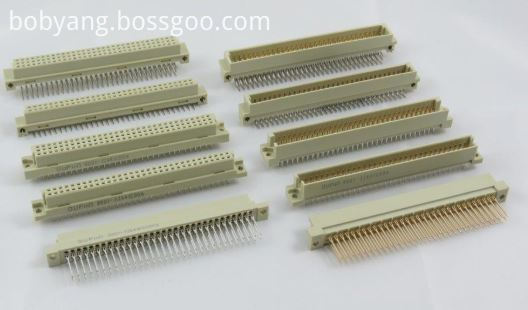
Half C, R, B & Q Type DIN41612 Connectors
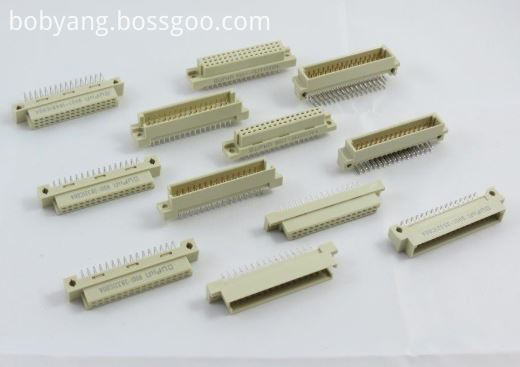
1/3 C,R, B & Q Type DIN41612 Connectors
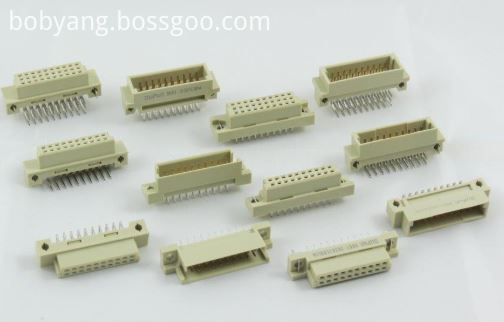
H, F, H+F & M type DIN41612 Connectors
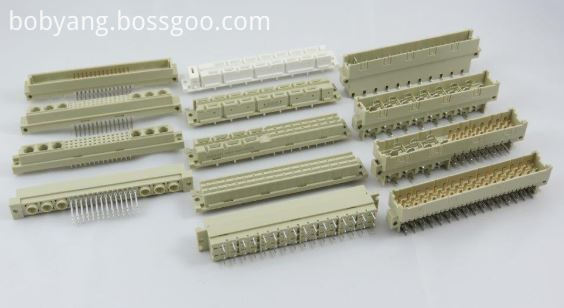
IDC Type DIN41612 Connectors
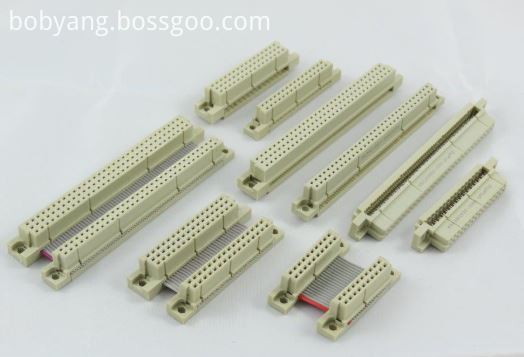
Female Cable Connector
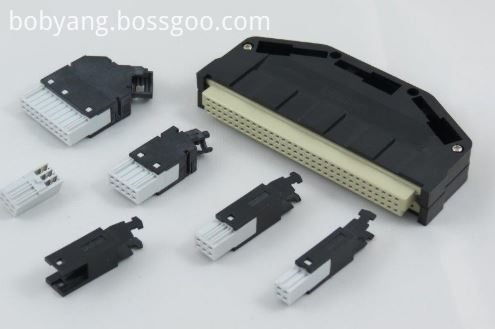
High Pin Count DIN41612 Connectors
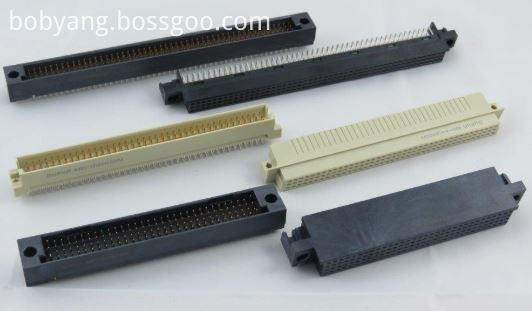
Shroud DIN41612 Connectors
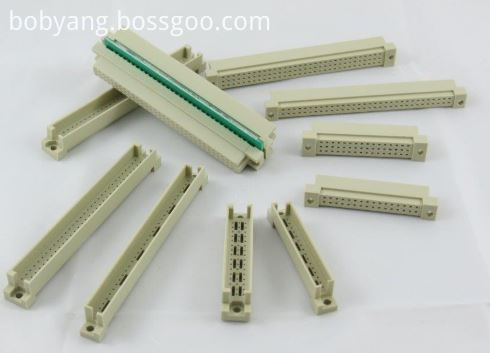
Features and Benefits of Din41612 Connector:
• Indirect mating (male/female)
• Automated production processes
• Continuous quality assurance
• 3-160 contacts
• Complete interconnection system
• Numerous interface connectors
• A wide variety of hoods
• Many termination technologies provide for the lowest installed cost
• Contacts selectively gold-plated
• Tinned terminations for increased solderability
Uses
The primary use of DIN 41612 connectors are PCB Connectors and motherboards, the main acceptance would be their board to board reliable connections.
Applications of Din41612 Connector:
Applications
• Data centers
• Storage
• Servers
• Base stations
• Telecommunications equipment
• Backplane and motherboard assemblies
• Switching systems
• Modular rack systems
• Power automation
• Distributed control systems in
industrial control
• Programmable logic controllers (PLC)
• Robotics
• Test and lab equipment
• Energy distribution
• Monitoring equipment
This is not a definitive list of applications for this product. It represents some of the more common uses.
Din41612 Connectors,Din 41612,Eurocard Connector Din41612,Male Din41612 Connector
ShenZhen Antenk Electronics Co,Ltd , https://www.antenkcon.com